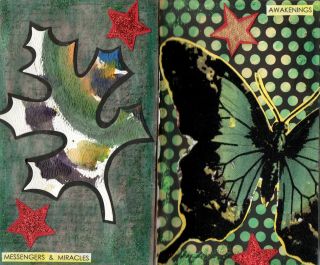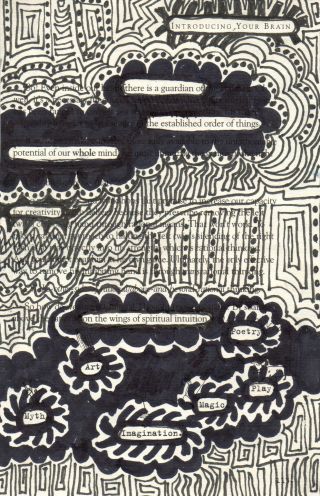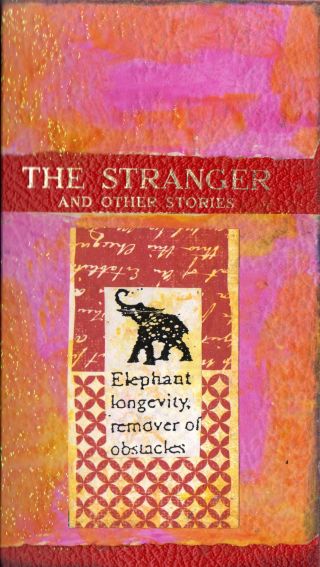Self-Control
Altered Book and Visual Journaling
Changing the story through “altered” art therapy and visual journaling.
Posted December 23, 2013

Messengers, Miracles, Awakenings by C. Malchiodi © 2013
Visual journaling (aka art journaling) has a long history in the field of art therapy, particularly as an approach to assist recovery from trauma or loss and as a form of stress reduction. The previous three posts on this topic address how visual journaling assists emotional reparation and supports self-regulation and stress reduction. I also shared some popular visual journaling prompts used in art therapy and general guidelines for applying these strategies to your own self-expression and exploration. One of these prompts is the “altered book” and is the final installment of this four-part series on visual journaling for self-expression, health and well-being.
Technically, an altered book is a form of mixed media artwork that changes a book from its original form into something different, altering its appearance or intended meaning. The book itself can be cut, collaged, painted or otherwise changed or transformed in some way. These alterations often incorporate the book’s text and/or illustrations; in fact, you can simply use a felt marker or pen to highlight certain words or phrases, creating altered prose and poetry [see illustration]. The Altered DSM III by Ron Huxley is one of my favorite examples of an altered book found at http://www.flickr.com/photos/rehuxley/sets/316407/show/. Huxley’s innovative concept of the altered book may inspire some of us to take a creative crack at the DSM IV and V someday!

Altering the text in a book by C. Malchiodi © 2013
From an art therapy perspective, creatively altering a book can be a form of rewriting one’s life story through visual journaling. It is similar to the process of narrative therapy, but taking the approach a step further through redefining the story through not only words, but also images. Harriet Wadeson, a well-known art therapist, author and researcher, applied altered book journaling to her own struggles with cancer and describes the experience in her book, Journaling Cancer in Words and Images. Wadeson refers to the process as an “altered book for an altered life;” in her case, it is a life profoundly changed by a cancer diagnosis and subsequent treatments and challenges. Her altered book contains not only images of pain, suffering and the realities of illness and treatment, but also beauty, inspiration and transformation in words and symbols.

The Stranger, an altered book by C. Malchiodi © 2013
I recently took a cue from Wadeson’s altered book -- when confronted by a mild traumatic brain injury [TBI] earlier this year, I started to re-author the narrative of my concussion via a book called “The Stranger” [not the Camus version, but a novella by another author]. The book’s title reflected my initial post-TBI status of “not feeling like myself,” a shared experience that almost everyone who has had a closed head injury reports. I used the experience of creating an altered book first as a relaxing and stress-reducing pastime when my cortex was literally too tired to think; I just allowed myself to enjoy working with colored paper, pens and paints to alter pages without judgment. As I began to recuperate, the pages evolved into images and prose depicting my process of recovery and the eventual realization that I was very fortunate indeed to have not experienced the more serious symptoms that many individuals with TBIs encounter. Ironically, the last page of the book was completed on the three-month anniversary of the injury, a day that coincided with the predicted “complete” recovery date according to my doctors. My last image summarized this milestone and it is a message that I now share with individuals I see in my art therapy who have sustained a TBI or are challenged by other conditions. The page says, “You can let Rays of Hope pull you in every direction,” a personal awakening to the benefits of a positive outlook when confronted with physical or emotional challenges.
Of course, there is much more to the story of my altered book and newly discovered narrative than I can describe here. But as a therapist who professes the importance of resilience in reparation and recovery, engaging in this form of visual journaling turned out to be more powerful than I originally anticipated. All art making is in some way about transformation and renewal; altered art empowers the creator to restore what has been lost and make changes to what already exists through symbol and metaphor. In brief, my simple altered book not only helped to re-author the experience of mild TBI, it also empowered me to honor and transform my healing journey through art and image.
Keep Calm and Art Therapy On in 2014,
Cathy Malchiodi, PhD, LPCC, LPAT, ATR-BC
© 2013 Cathy Malchiodi
www.trauma-informedpractice.com
Resources
Altered Art Therapist blog by Jennifer Navarro at http://jennavarro.com/?s=altered+books
General information and inspiration on altered books via “Go Make Something” at http://gomakesomething.com/category/ht/ab/
Art Journaling and Altered Books on Pinterest at http://www.pinterest.com/cathymalchiodi/art-journaling-altered-books/
Creative Arts and Play Therapy for Attachment Problems [Guilford Press, 2014] is now available! Go to http://bit.ly/JZl2vr for more information and to download a sample chapter.


